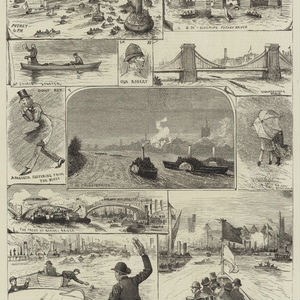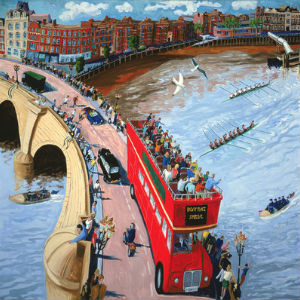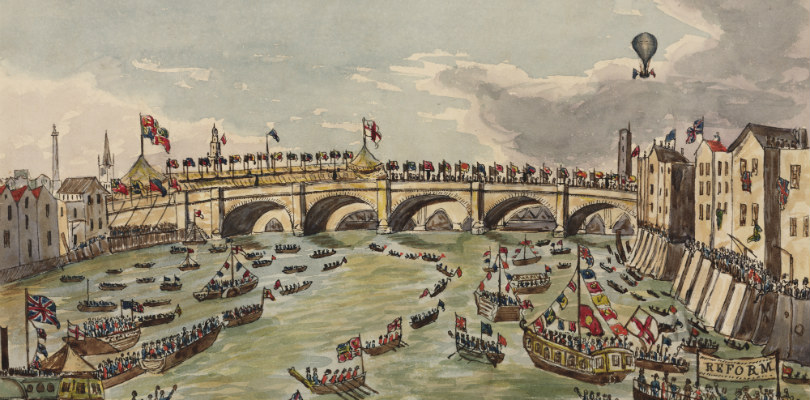
Crossing the Thames: London’s Best Bridge(man)
London may not be able to compete with Venice, or even Birmingham, for total number of bridges, but in terms of quality, London has some of the most famous and most beautiful bridges traversing the Thames. Here are some facts on the oldest, the furthest and most famous crossings illustrated with images from the Bridgeman collection.
The oldest one
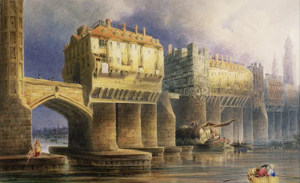 |
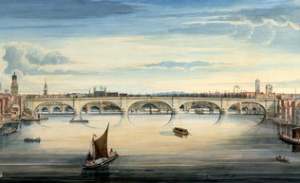 |
|
| Old London Bridge in 1745 by Joseph Josiah Dodd © Guildhall Art Gallery, City of London |
West view of New London Bridge and Old London Bridge, 1830 by Gideon Yates / Photo © Bonhams, London, UK |
There has been a bridge crossing the Thames between the City and Southwark since Roman times.
The first permanent stone bridge was built from 1176 to 1209 and first opened under the reign of King John. Building the bridge was so expensive that John was forced to license building plots on the bridge. Some of the resulting buildings were seven storeys high, causing numerous fires and putting extreme weight on the bridge. To prevent this London bridge falling down, it was completely rebuilt between 1824 and 1831, with a granite design by John Rennie, the Scottish civil engineer who also designed bridges at Waterloo, Southwark and Vauxhall. Rennie’s bridge was eventually replaced by a concrete bridge opened by Her Majesty the Queen in 1973, with Rennie’s granite bridge sold to the American chainsaw entrepreneur Robert P. McCulloch and re-erected in Lake Havasu City, Arizona. Rumours that McCulloch thought he was buying Tower Bridge persist to this day, although the man himself denied it.
The newest one
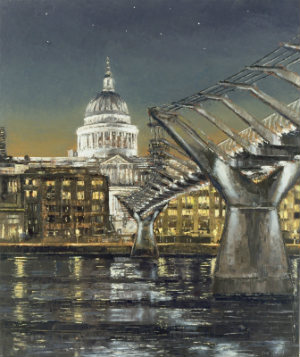 |
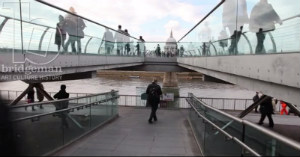 |
|
| St Paul’s and the Millennium Bridge, 2004 by Tom Young / The Art Bank Gallery |
Millennium Bridge in London © Samuel Magal, Sites & Photos Ltd. |
The London Millennium Footbridge opened on 15 June 2000 and closed two days later to “synchronous lateral excitation” which made the bridge sway and earned it the nickname the “Wobbly Bridge”. Since reopening in 2002, the Millennium Bridge has become a tourist favourite, offering stunning views of Tate Modern and St Paul’s at either end, despite the bridge collapsing – albeit fictionally – in the film version of Harry Potter and the Half-Blood Prince.
The proposed one
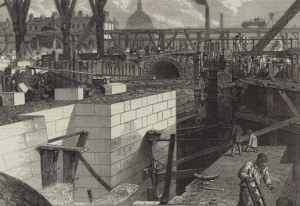 |
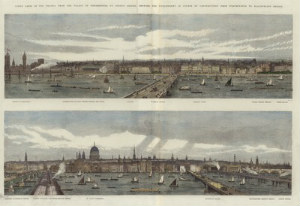 |
|
| Progress of the Thames Embankment near Arundel Street / © Look and Learn / Illustrated Papers Collection |
North bank of the Thames, 1865 / © Look and Learn / Bernard Platman Antiquarian Collection |
Champion of the Gurkhas (and my celebrity neighbour) Joanna Lumley is one of the names behind plans for a new “Garden Bridge” set to span the Thames between Temple Station and Queen’s Walk on the South Bank. Designed by Thomas Heatherwick and horticulturalist Dan Pearson, the bridge has been hounded by controversy, with criticisms of the cost and questions about whether an additional crossing on the river is necessary. If the bridge goes ahead, it will undoubtedly attract tourists from across the globe in the same way that the Highline has become a tourist hit over in Manhattan. The Garden Bridge isn’t the only proposed new crossing: bridges from Nine Elms to Pimlico and Canary Wharf to Rotherhithe have also been mooted.
The one furthest west
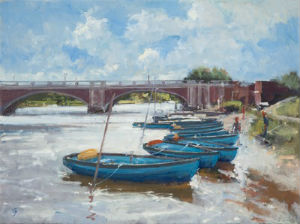 |
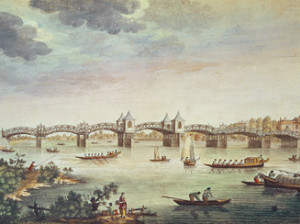 |
|
| Moorings at Hampton Court, 2011 by Christopher Glanville / Private Collection |
View of the Bridge over the Thames at Hampton Court, 18th Century / Polesden Lacey, Great Bookham, Surrey |
Hampton Court Bridge is the most upstream bridge across the Thames in Greater London. The modern bridge dates from 1933 and is perfectly attractive but the original wooden bridge across the river is perhaps more intriguing. Built in 1752, it stood barely twenty-five years, had seven wooden arches and was heavily influenced by Willow pattern Chinoiserie: a little mini Chinatown bridge in west London.
The one furthest east (and the most famous)
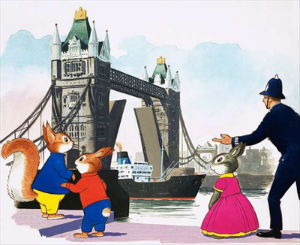 |
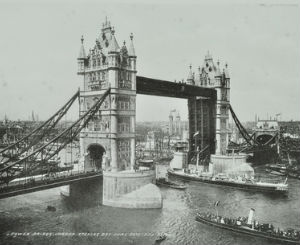 |
|
| Tufty and London Bridge (sic) / Private Collection / © Look and Learn | Tower Bridge on the day of its opening, 1894 / London Metropolitan Archives, City of London |
When former Black-Eyed Pea Fergie filmed the music video for her song London Bridge, the bridge that actually features in the clip isn’t London Bridge but the more recognisable Tower Bridge.
Fergie needn’t feel bad, though: plenty of people confuse London and Tower Bridge – including poor Tufty in the illustration above. Tower Bridge is a late Victorian drawbridge – or, more correctly, a double leaf “bascule” bridge (bascule, from the French bas, meaning low, and cul, meaning bottom), with the two bascules being raised on average three times a day. Although undoubtedly a London icon, the bridge had its fair share of detractors when first built, including the Pall Mall Gazette which pronounced it to be “huge but childish” with an “unparalleled lack of proportion” and “niggled and meaningless ornamentation”. No mention of its low bottom, though.
The political ones
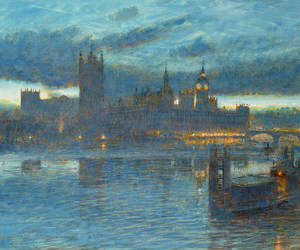 |
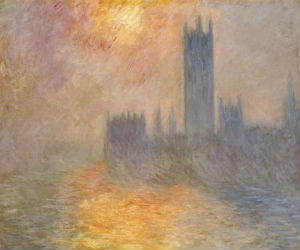 |
|
| Westminster from Lambeth Bridge, 1912 by Albert Goodwin / Private Collection / Photo © Chris Beetles Ltd, London |
The Houses of Parliament, Sunset, 1904 by Claude Monet / Photo © Christie’s Images |
Westminster and Lambeth Bridges flank the Houses of Parliament, and the green and red colours of the bridges are said to match the colours of the seats in the House of Commons and House of Lords. The area between the two bridges offers the best views of the Queen Elizabeth Tower, better known to everyone as Big Ben. Claude Monet knew this: he chose a spot at St Thomas’ Hospital near to Westminster Bridge to paint his sequence of paintings of the Houses of Parliament in 1904-05, and for me, crossing the Thames from south to north across Lambeth Bridge on the top deck of a number 3 bus is one of the best views of the city you can get, and all for the price of a bus journey.
The sporty one
One story runs that King George II, when Prince of Wales, found having to get the ferry across the river on his return from hunting trips to Richmond Park, pressed for the construction of the first 18th century version of the bridge. Each Easter since 1845 the Oxford and Cambridge Boat Race has started from Putney Bridge in south-west London. It’s also the only London bridge to have a church at each end, with All Saints Church on the north side also famous for being the location where Patrick Troughton was impaled with a lightning conductor in the original version of The Omen.
The prettiest one
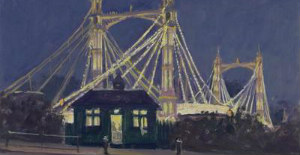 |
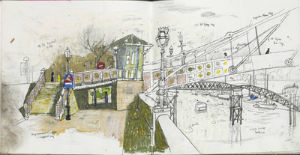 |
|
| Albert Bridge – Night (detail) by Julian Barrow / Private Collection | Albert Bridge, North Side by Leon Morrocco / Private Collection |
A couple of completely subjective awards to finish with: As someone who enjoys running through London, I have a personal affection for Albert Bridge. In the winter months, the twinkling lights on the bridge cheer up an otherwise dark, cold run home. In the summer, the sign warning troops from the nearby barracks that they must break march when crossing always makes me smile and reminds me that the Millennium Bridge wasn’t the first wobbly bridge in London!
The one with the best view
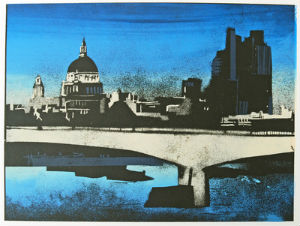 |
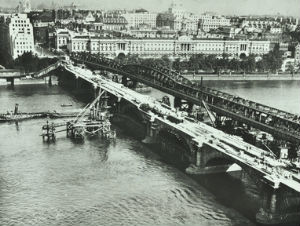 |
|
| St Paul’s and Waterloo Bridge by Jo Bowen / Private Collection | Waterloo Bridge: demolition of old bridge, 1934 / London Metropolitan Archives, City of London |
The view from Waterloo Bridge inspired the Kinks to write Waterloo Sunset. For any fan of 20th-century architecture Waterloo Bridge offers an extraordinarily fantastic view of the London skyline, with the National Theatre and the Royal Festival Hall on the South Bank, the Art Deco 80 Strand on the north side, and views of the Barbican towers in the distance. As the bridge was constructed during the Second World War it was built mostly by women, earning it the nickname “The Ladies’ Bridge”. Replacing a previous, narrower bridge from the early 1800s, the bridge was designed by Sir Giles Gilbert Scott whose other works, including the Battersea Power Station, the K2 red telephone box and Tate Modern, have shaped London’s streets and skyline for decades.
If the images above have whetted your appetite, we have created a lightbox with more images of some of London’s best bridges. Spoiler warning: the selection does contains an image of the Village People in front of Tower Bridge…

